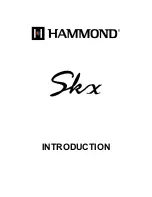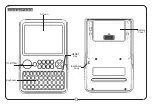
Program mode: HD-1
30
The list of Multisamples, Wave Sequences, or Drum
Kits can be quite long. The sliders or knobs will let you
sweep through the entire range, but it may not be
possible to select all of the intermediate values. You
can always select any individual item by using select
the on-screen parameter and use the standard data
entry controls, such as the INC and DEC buttons.
You can also limit the range of the control by using the
Min #
and
Max #
parameters, described below.
PROG
restores the Program’s original Multisamples
and Wave Sequences (or the Drum Kit, for a Drum
Program), including all velocity ranges and
Reverse
and
Start Offset
settings.
For Single and Double Programs:
•
MS/WS/DKit Select
overrides all of the
Multisample Velocity zones, so that the newly
selected Multisample or Wave Sequence plays over
the entire velocity range.
• By default, you can select from the same Bank as
the original Program’s MS1.
• Also by default, if the original Program’s MS1 is a
Multisample, you can select Multisamples; if MS1 is
a Wave Sequence, you can select Wave Sequences.
• You can use the
MS/WS Type
and
MS/WS/DKit
Bank
parameters, described below, to change these
defaults as desired.
For Multisamples only:
• You can use the Tone Adjust
Reverse
and
Start
Offset
parameters to modify the newly selected
Multisample. By default, the
Reverse
is set to
Off
,
and its
Start Offset
is set to
0
.
For Drum Programs:
• By default, you can select from the same Bank as
the original Program’s DrumKit. You can use the
MS Bank
parameter, described below, to select a
different Bank.
MS/WS Type
.
(Off/MS/WavSeq, Meta)
This Meta-parameter modifies the
MS/WS Select
parameter, so that you can specifically choose to select
either Multisamples or Wave Sequences.
It applies only to Single and Double Programs, and has
no effect with Drum Kits.
MS Bank. (ROM Mono…, Meta)
This Meta-parameter modifies the
MS/WS/Dkit Select
parameter, so that you can select Multisamples from
any Bank you like.
MS/WS/DKit Min #
.
(0…16383, Meta)
This Meta-parameter sets a minimum value for the
MS/WS/Dkit Select
parameter. You can use this in
conjunction with the
MS/WS/DKit Max #
parameter,
below, so that a knob or slider selects only from a small
set of choices. This is particularly convenient with the
internal ROM, in which similar Multisamples are
grouped together. For instance, this makes it easy to
select between a group of bells, or a set of electric
basses.
MS/WS/DKit Max #
.
(0…16383, Meta)
This Meta-parameter sets a maximum value for the
MS/WS/Dkit Select
parameter. Please see
MS/WS/DKit Min #
, above, for more information.
Start Offset
.
(0…8, Absolute)
This allows you to change the Start Offset of the
Multisample specified by the
MS/WS Select
parameter. It applies only when:
• The Program is a Single or Double (not a Drum Kit)
• The
MS/WS Select
parameter is used to select a
Multisample (not a Wave Sequence)
For more information on Start Offsets, see “Start
Offset” on page 51.
Drive
.
(0…99, Absolute)
This controls the Oscillator’s
Drive
parameter, as
described under “Drive” on page 73.
Low Boost
.
(0…99, Absolute)
This controls the Oscillator’s
Low Boost
parameter, as
described under “Low Boost” on page 74.
Pitch Slope
.
(–1.0…2.0, Absolute)
This controls the Oscillator’s
Pitch Slope
parameter, as
described under “Pitch Slope” on page 53.
LFO 1 Waveform
.
(Triangle…Rad6, Absolute)
This selects the waveform for the Oscillator’s
LFO 1
, as
described under “Waveform” on page 83.
LFO 2 Waveform
.
(Triangle…Rad6, Absolute)
This selects the waveform for the Oscillator’s
LFO 2
, as
described under “Waveform” on page 83.
Amp LFO 1 Intensity
.
(–99…+99, Absolute)
This controls the depth and direction of Amp
modulation from LFO1, as described under “4–2c: LFO
1/2” on page 77.
Amp LFO 2 Intensity
.
(–99…+99, Absolute)
This controls the depth and direction of Amp
modulation from LFO2, as described under “4–2c: LFO
1/2” on page 77.
Filter LFO 1 Intensity to A
.
(–99…+99, Absolute)
This controls the depth and direction of Filter A cutoff
modulation from LFO1, as described under “3–3a: LFO
1/2” on page 67.
Filter LFO 1 Intensity to B
.
(–99…+99, Absolute)
This controls the depth and direction of Filter B cutoff
modulation from LFO1, as described under “3–3a: LFO
1/2” on page 67.
Filter LFO 2 Intensity to A
.
(–99…+99, Absolute)
This controls the depth and direction of Filter A cutoff
modulation from LFO2, as described under “3–3a: LFO
1/2” on page 67.
Filter LFO 2 Intensity to B
.
(–99…+99, Absolute)
This controls the depth and direction of Filter B cutoff
modulation from LFO2, as described under “3–3a: LFO
1/2” on page 67.
Pitch LFO 1 AMS Intensity
.
(–12.00…+12.00,
Absolute)
You can use an AMS source, such as aftertouch, to
modulate the depth of pitch modulation (vibrato) from
LFO1. This controls the intensity of that AMS
modulation. For more information, see “4–2c: LFO
1/2” on page 77.
Pitch LFO 2 AMS Intensity
.
(–12.00…+12.00,
Absolute)
This is similar to
Pitch LFO 1 AMS Intensity
, above.
Summary of Contents for Electronic Keyboard
Page 1: ...Parameter Guide Parameter Guide ...
Page 2: ......
Page 180: ...Program mode EXi 170 ...
Page 290: ...EXi STR 1 Plucked String 280 ...
Page 572: ...Sequencer mode 562 ...
Page 700: ...Global mode 690 ...
Page 751: ...Insert Effects IFX1 IFX12 Routing 741 Fig 2 3a Fig 2 3b ...
Page 902: ...Effect Guide 892 ...
















































